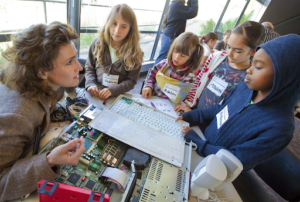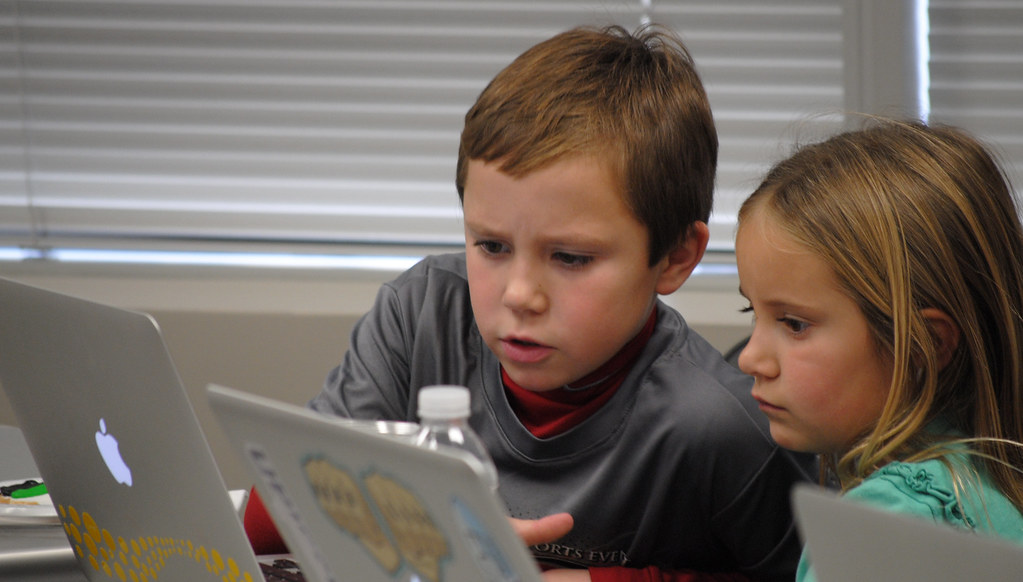I fondly remember my first purpose-driven experience that exposed elementary students to Computer Science through Code.org’s Hour of Code. Our team collaborated with local computer science professionals to introduce coding and programming to our elementary students and teachers. These industry experts worked side by side with children in Kindergarten through 8th grade, making Elsa from Frozen skate across the ice or helping Steve and Alex embark on an adventure in Minecraft. It was a tremendous PR opportunity and likely opened many students’ eyes to computer science as a potential career.
I vividly recall a very sobering statistic from that experience regarding the shortage of qualified candidates needed to fulfill the projected demand for computer science careers by 2020. What I also recall is that once we left the room, very few teachers knew how to build upon the foundation that we had laid. The hooks were in the mouths of the fish; there just wasn’t anyone reeling them in!

Introducing and providing ongoing opportunities for elementary and middle school-aged students to engage in CS-based learning activities is crucial to preparing them for their futures. It allows those who have already indicated and demonstrated the passion and skills to further their experience, while also serving as a window for underrepresented students who might not otherwise be exposed to the field.
While some progress seems to have been made regarding the meaningful implementation of digital literacy and computer science education, there is still so much work to be done in order to equitably prepare our students to thrive in an ever-increasingly digitally dependent world. Some of the notable contributors to the nonprofit advancement of CS education include Google, MIT’s Scratch, and Code.org, but you too, as an educator or leader, can make a significant impact on preparing today’s students for tomorrow’s world.

To address this challenge, let’s use the algorithmic thinking process, which is a key component of computational thinking.
Step 1
Problem identification: Although required per state standards, Equitable, ongoing, and high-quality CS education is not being provided for all students.
Step 2
Explore the problem. Why not? While I’m not questioning the validity of the “no time” explanation, I contend that it’s much deeper than that. People generally make time for those things which they value. To compound the situation, even if the value was shared amongst all teachers, the comfort level, confidence, and knowledge base required to deliver high-quality instruction and learning opportunities is still lacking.

Step 3
Examine sample instances. I’ve been in the Education Technology Integration world for seven years now and, through a comparison of teachers’ general disposition towards the use of technology, my informal conclusion is that fear, unfamiliarity, and discomfort are what serve as the barriers to consistent and high-quality implementation of grade-appropriate computer science instruction.
Step 4
Implement a solution. Thankfully, for Indiana K-8 teachers at least, the Indiana Department of Education has gone to great lengths to provide a number of robust teaching resources and student-facing activities that help educators start the process of overcoming their fears. As mentioned before,Code.org, Scratch and Google provide resources, a curriculum, and professional development to help teachers master the skills and obtain the experience needed to provide meaningful, purpose-driven computer science and digital literacy learning opportunities for their students. For more information on the K-8 computer science standards, including more links to resources, check out my playlist on Keep Indiana Learning’s YouTube channel.
Step 5 and 6
Test and evaluate. Only the teachers, school buildings, or school districts themselves can perform these steps after implementing a well-supported computer science education initiative for their students.

If you are like me and have a full appreciation of the critical role that technology plays in virtually every aspect of our lives, you may also share my growing concern that we may not be building the capacity to sustain, grow, or improve the positive systems that we have in place. If you don’t share my appreciation for how vital technology has become and its growing role in the days to come, I encourage you to reflect on just how dependent you are on technology working and the impact that it has on your overall productivity. The next time you are at the doctor, restaurant, stoplight, sporting event, store, or school – just look and listen. What role does technology play in these environments and systems? Beyond that, challenge yourself to conduct your own research regarding how technology has impacted such industries as farming, transportation, manufacturing, security, entertainment, and warehousing. What you would likely conclude is that, even if you don’t understand it, we are dependent on technology and its positive advances in virtually limitless ways.
We have an obligation to prepare our students to participate in these industries, whether it be as an engineer, designer, operator, programmer, or consumer. The great news is that thanks to the resources that I mentioned and the countless other free and subscription-based resources, we have the tools and platforms we need to solve this problem and provide the high-quality, equitable computer science and digital literacy education that our students deserve!
Resources
Please login or register to claim PGPs.
Alternatively, you may use the PGP Request Form if you prefer to not register an account.



